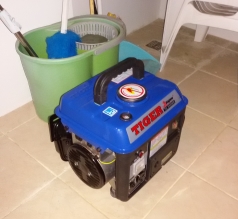|
Question:How can you have 230 volt resp. 110 volt power anytime and anywhere? Answer:In today's society, electricity has become indispensable. We have become extremely dependent on it because of its usefulness. In modern societies you hardly ever have power outages anymore, at least not in heavy populated areas. But if you go a little bit off the beaten track, e.g. into the garden or wild camping, you suddenly feel this dependence again. Especially in areas or countries with above-ground power lines it happens again and again that a power interruption occurs. In all these cases one would be glad to have just one kilowatt at hand. And now for the good news: Something like that exists! There is a small Chinese wonder thing, a portable power generator, that runs on gasoline. The device weighs only 20 kg and is under 40 cm (16") in cubic size: This device is available in various shops and also online all over the world, in each case "branded" differently , i.e. under the name of the respective import company. In the USA it's called for example "Chicago", "Storm Cat" or "PowerPro", in the Philippines "Lotus", in China "Tiger" and so on. There are three variants with different performance, the TG650, TG950 and TG1000. They have a tank with 4 litres (1 gallon), which keeps them running for about 5-6 hours. There are many variants, some have a single outlet with a 230 volt or 110 volt AC socket, some have multiple outlets and most have an additional 12 Volt DC outlet. I have scanned the operating instructions for interested people because I haven't found them anywhere on the net:
The costs are very attractive: In the USA such a device is sold for approx. 79$-120$, in other countries it can cost up to 180 €/$. One can compare this with a power supply by batteries: Even a single car battery costs more than 70$. For our application you should not use lead-acid batteries anyway, but deep-discharge-resistant batteries, i.e. gel or AGM, which is also in use for photovoltaic batteries. These cost however approx. 150$ or up. If you add the inverter to the calculation, which turns the 12V DC current into 230V resp. 110V AC, you have to add another 100-200$. The result is that for a short time you get little electricity and you have to replace the batteries every few years for a lot of money. So the generator has a clear advantage in terms of cost and performance, especially if it is used only sporadically. Here is another important point: The output voltage can fluctuate slightly if the load falls below 100W, and also if strong loads are switched on and off. You should be careful with devices that are sensitive to this. As compensation I recommend to connect it to a UPS (Uninterruptible Power Supply). It does a very good job of stabilizing the voltage. Such devices don't cost much either, around 150 $/€/CHF for up to 1000W, and as a bonus for PCs and video boxes you get constant protection against short power cuts and lightning strikes. I appreciated the generator especially when our building complex shut down the power for line repairs for about 7 hours. As an exception this was an advertised shutdown, for once. With such long power outages there was no chance that my stuff in the freezer compartment of the fridge would go unharmed. According to my observations about 3 hours was the maximum before the ice creams inside began to melt. So I connected the fridge to the output of my 1500 Watt UPS and it worked, easily. The UPS didn't even bat an eyelash, the display showed only low power consumption. After about 20 minutes the freezer was back to its normal temperature and the generator could be stopped. In the end, you could say the generator saved the day (along with all the other stuff in the fridge). Such an emergency power generator has also a few disadvantages:
But these disadvantages are overcompensated by a constant and everywhere available power supply of approx. 600 to 1300 Watt (depending on the model). With it you can easily run a refrigerator, a PC with monitor, a TV with amplifier, a video box, various lamps and lots of mobile phone chargers at the same time. If you also have a gasoline canister, you can keep this up for practically any length of time. Power failures due to icy cold or harsh storms can't harm you anymore, definitely also a psychological advantage. Working in a remote place is no longer a problem, e.g. sawing, drilling, milling and soldering. Charging an empty car battery without an outlet in the vicinity is now suddenly possible and electricity for a food cooler, lamps and chargers for a camping trip is also included.
|
||
|
|
||
| © 2017 Andres Rohr. This topic stems from the author himself. It is not simply copied from the internet.
|
||



